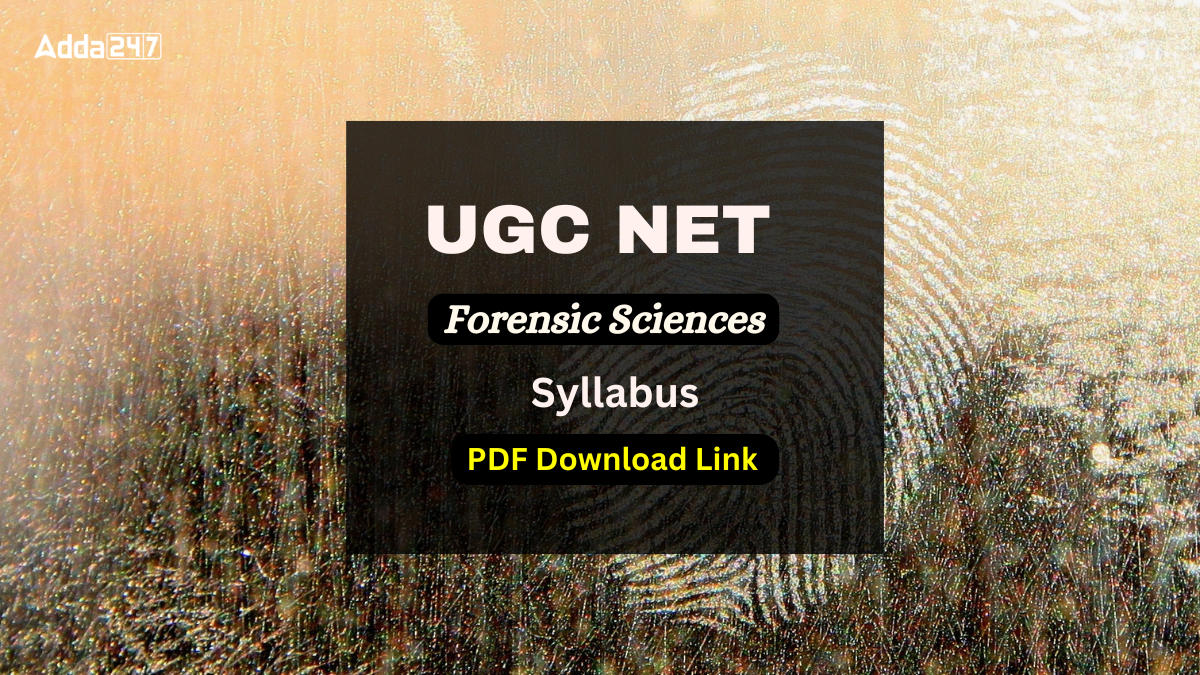Table of Contents
UGC NET Forensic Science 2025 has been released on the official website. Aspirants must prepare rigorously and need a syllabus for their chosen subject. Candidates preparing for the NET Forensic Science Exam must know about the Forensic Science Syllabus 2025 through the article below. The UGC NET Forensic Science syllabus encompasses various sections including DNA analysis, ballistics, toxicology, fingerprint analysis, and others. Candidates can check the detailed UGC NET Forensic Science Syllabus 2025 with detailed exam patterns in the article below.
UGC NET Forensic Science Syllabus 2025
The UGC NET Forensic Science syllabus covers the definition, history, and ethical considerations of forensic science, alongside analytical techniques like microscopy and chromatography. Biological evidence analysis includes bloodstain detection and DNA analysis, while toxicology covers substance analysis. Firearms and explosives examination, physical evidence analysis, computer forensics, identification techniques, document examination, and medicolegal importance are also emphasized. This comprehensive overview prepares candidates for research, teaching, and professional roles in forensic science.
UGC NET Forensic Science Exam Pattern
The UGC NET Forensic Science syllabus and exam pattern together form a structured framework for evaluating candidates’ knowledge, analytical skills, and proficiency in the diverse domains of Forensic Science. The UGC NET examination for Forensic Science Subject follows a structured exam pattern to assess candidates’ knowledge and understanding of the subject. The exam consists of two papers: Paper I and Paper II.
- Paper I: Teaching Aptitude, Research Aptitude, Comprehension, Communication, Mathematical Reasoning and Aptitude, Logical Reasoning, Data Interpretation, Information, and Communication Technology (ICT), People, Development and Environment, Higher Education System
- Paper II: Subject-specific test focusing on the chosen discipline (Forensic Science).
UGC NET Forensic Science Important Topics
The important topic for UGC NET Syllabus of Forensic Science has been explained below.
- Crime Scene: Nature, Types, Preservation of Scene of Crime
- Neutron Activation Analysis
- Blood Group Systems
- Analysis of Methanol and Denaturants
- Gunshot residues analysis
- Explosives: Definition, Types and Analyses
- Dust & Soil: Nature, Types, Forensic Examination
- Examination of Chance Prints, Computerization of Fingerprints, AFIS
- Indentations, Secret writings and Charred documents
- Post-mortem examination and post-mortem changes, Estimation of time since death
UGC NET Forensic Science Syllabus Detailed
UGC NET Forensic Science Syllabus Topic-wise has been explained below. Check the detailed topics list for Forensic Science –
Unit – I
- Forensic Science: Definition, History & Development, Scope, Ethics in Forensic Science
- Physical Evidence: Nature, Types, Search methods, Collection, Preservation, Packing & Forwarding of Physical & Trace evidence for forensic analyses, Chain of Custody
- Crime Scene: Nature, Types, Preservation of Scene of Crime
- Criminal Investigations: Unnatural deaths, Criminal assaults, Sexual offences, Poisoning, Vehicular accidents
- Courts: Types, powers and jurisdiction, Admissibility of evidence in Courts, Definition of Experts, Provisions in Cr.P.C.,1973 & Indian Evidence Act relating to experts & their reports; Court Procedures pertaining to Expert Testimony & Witness
- Organization of Forensic Science Laboratories of Centre and State, NCRB and NICFS
- Fundamental Rights: Right of Equality (Articles 14 to 18) and Right of Freedom (Articles 19 to 22) as per the Constitution of India
- Criminal Profiling: Profile of victim and culprit, its role in crime investigation, Lie detection (Polygraphy), Narco analysis, Brain mapping, scope and limitations
- Concept of quality control management in Forensic institutions.
Unit – II
- Microscopy: Polarizing, Comparison, Stereoscopic, Fluorescent and Electron Microscopes
- Spectrophotometry: UV, Visible, IR, Raman, Atomic absorption, Emission
- Neutron Activation Analysis
- X-rays and x-ray-based techniques such as XRD, XRF
- Mass Spectroscopy
- Chromatographic Techniques: TLC, GLC, HPLC, HPTLC
- Hyphenated Techniques: GC-MS, LC-MS, IR-MS and ICP-MS
- Electrophoresis: High and Low voltage electrophoresis, Immunoelectrophoresis
- Immunoassays: Principles, Types, Techniques and Applications
Unit – III
- Detection and Identification of Bloodstains
- Determination of Species of Origin
- Blood Group Systems
- Techniques of Determination of Blood Groups of Blood Stains
- Detection of Seminal and other body fluids and their Blood Grouping, Red cells Enzymes, Serum Proteins of forensic significance
- Disputed Paternity & Maternity
- DNA: Structure, DNA as genetic marker, DNA Extraction and Profiling Techniques
- DNA Phenotyping and RNA Profiling & their Applications
- Wildlife Forensics: Wildlife (Protection) Act,1972, Scope, Evidence and Identification
Unit – IV
- Analysis of Ethyl alcohol in beverages, liquors, biological fluids and breath
- Analysis of Methanol and Denaturants
- Illicit liquors
- Analysis of Chemicals in Trap Cases
- Metabolism and Chemical examination of:
- Insecticides & Pesticides
- Tranquillizers & Sedatives
- Hypnotics Stimulants
- Narcotics
- Opiates
- Drugs of abuse; Analyses of the above and their Toxicity
- Plant poisons
- Metallic Poisons
- Extraction, Isolation & Clean-up procedures, Identification of common poisons from viscera, tissues and body fluids
Unit – V
- Firearms: Types, Classification, Ammunition and Their Compositions
- Forensic examination of Firearms, Ammunition, Firearms projectiles (Bullets, Shots, Slugs etc.), Shell case
- Gunshot residues analysis
- Concept of Velocity, Penetration, Dispersion, Ricochet, Accidental Discharge, Determination of Range in firearm cases
- Examination of Country-made firearms
- Basics of Internal, External and Terminal Ballistics
- Tool marks: Meaning, Types and Examination
- Restoration of Erased Markings on Metal Surfaces
Unit – VI
- Fire and Arson: Analyses of Petroleum Products and other incendiary materials
- Explosives: Definition, Types and Analyses
- Bombs: Country-made bombs, Improvised Explosive Devices (IEDs) and their examination
- Investigation in Explosion and Arson related cases
- Photography: Types, application in criminal investigation & Forensic evidence examination
Unit – VII
- Hair & Fibers: Nature, Types, Structure and Examination
- Pollens and Diatoms: Their application in Forensic investigation
- Dust & Soil: Nature, Types, Forensic Examination
- Paint, Lacquer & Varnishes: Nature, composition and forensic examination
- Glass: Composition, Types, Fractures, Examination
- Cement, Mortar and Concrete: General Composition, Forensic Analysis
- Computer Forensics: Introduction, Types of Computer crimes, Digital evidence- Seizure, Acquisition and Forensic examination
- Mobile Phone Forensics
Unit – VIII
- Fingerprints: History, Characteristics, Types, Classification, Preservation, Development, Lifting and Comparison,
- Examination of Chance Prints, Computerization of Fingerprints, AFIS
- Track Marks: Foot Prints, Shoe Prints, Tire Marks, Their Preservation & Casting, Comparison, and Skid marks. Gait pattern
- Biometric Systems of Identification and its Relevance
- Voice Analysis: Introduction, Significance, Structure of Human Voice apparatus, Voice spectrography, Voice analysis,
- Legal aspects and limitations
Unit – IX
- Documents: Definition, Types, Preliminary examination of documents
- Reproduction of documents through photographic and mechanical means and their examination
- Examination of Alterations such as Erasures, Obliterations & Additions
- Indentations, Secret writings and Charred documents
- Inks, Papers and their scientific examinations with modern methods
- Age of documents
- Examination of Typescripts, Printed matter including currency notes and lottery tickets. Mechanical impressions
- Hand writings: Class and Individual characteristics of Handwritings, Factors affecting handwriting, Standard samples for comparison, Comparison of hand-written texts
- Anonymous and disguised writings
- Identification of handwriting, signatures, detection of forged signatures and forgeries
- Examination of Credit Cards and Similar materials
Unit – X
- Modes & Manner of deaths, Sexual offences and its medicolegal importance, Amendments in law related to sexual offences
- Post-mortem examination and post-mortem changes, Estimation of time since death
- Injuries & Wounds: Types, Medicolegal importance, Gunshot wounds
- Determination of Species of Origin, Sex, Age, Stature, and individual identification through skeletal remains
- Identification through Skull superimposition and facial reconstruction
- Human dentition, Type of teeth, determination of Age, Bite marks
- Forensic Entomology: Introduction, Insects of forensic importance, Insects on Carrion, Forensic applications
Download UGC NET Forensic Science Syllabus PDF
Candidates can download the UGC NET Forensic Science Syllabus has been provided below. The direct link to download the UGC NET Forensic Science is available in Hindi and English PDF.
| UGC NET Forensic Science Syllabus | |
| UGC NET Forensic Science Syllabus – English | Click Here |
| UGC NET Forensic Science Syllabus – Hindi | Click Here |
UGC NET Forensic Science Qualifying Marks
The UGC NET Forensic Science examination qualifying marks category-wise have been explained below.
- General Category: 40% aggregate marks in both papers combined.
- OBC (Non-creamy layer)/PwD/SC/ST Categories: 35% aggregate marks in both papers combined.
| UGC NET Related Articles | |
| UGC NET Notification 2025 | UGC NET City Intimation 2025 |
| UGC NET Previous Year Question Paper | UGC NET Admit Card 2025 |




 JKSET Syllabus and Exam Pattern 2025, Do...
JKSET Syllabus and Exam Pattern 2025, Do...
 HPSC Assistant Professor Syllabus 2025 a...
HPSC Assistant Professor Syllabus 2025 a...
 DSSSB TGT Syllabus & Exam Pattern 20...
DSSSB TGT Syllabus & Exam Pattern 20...




